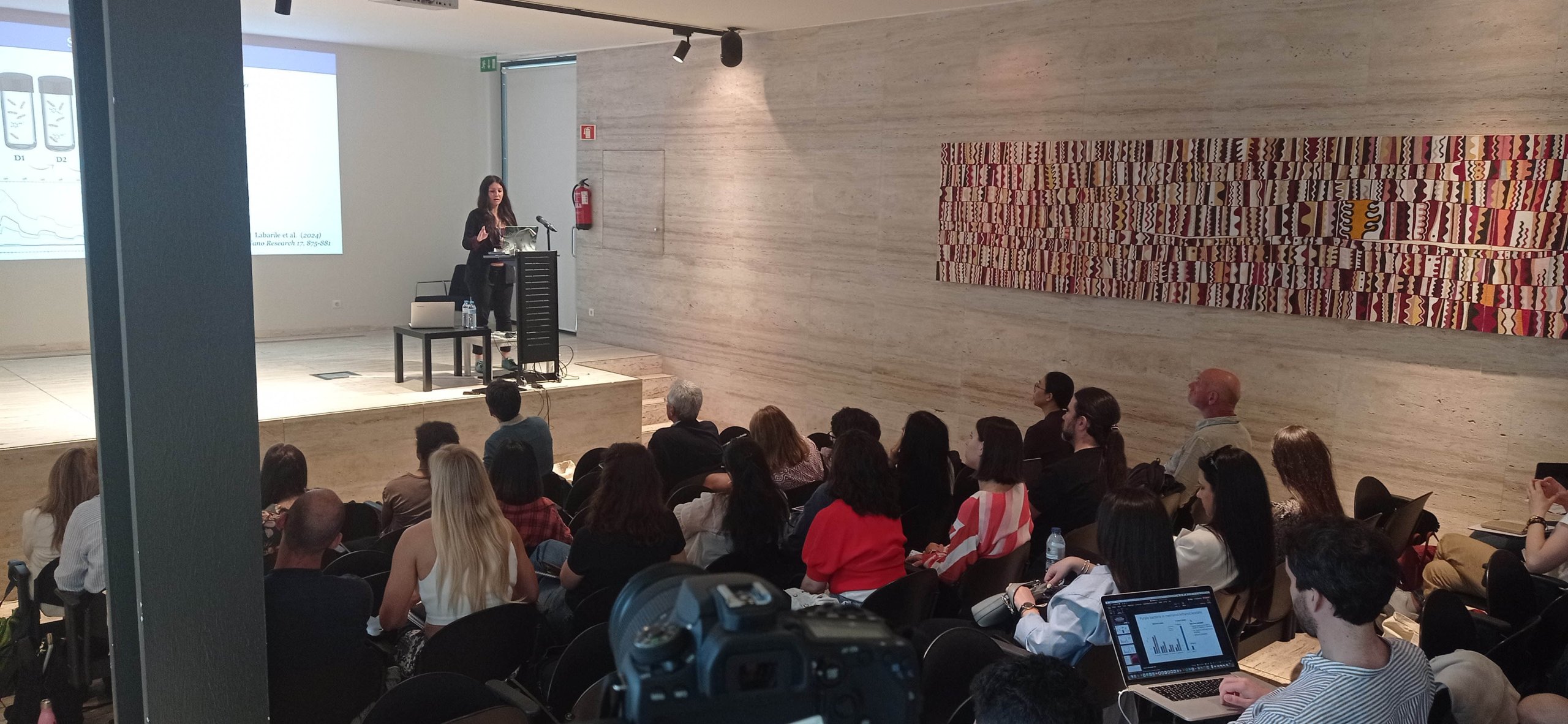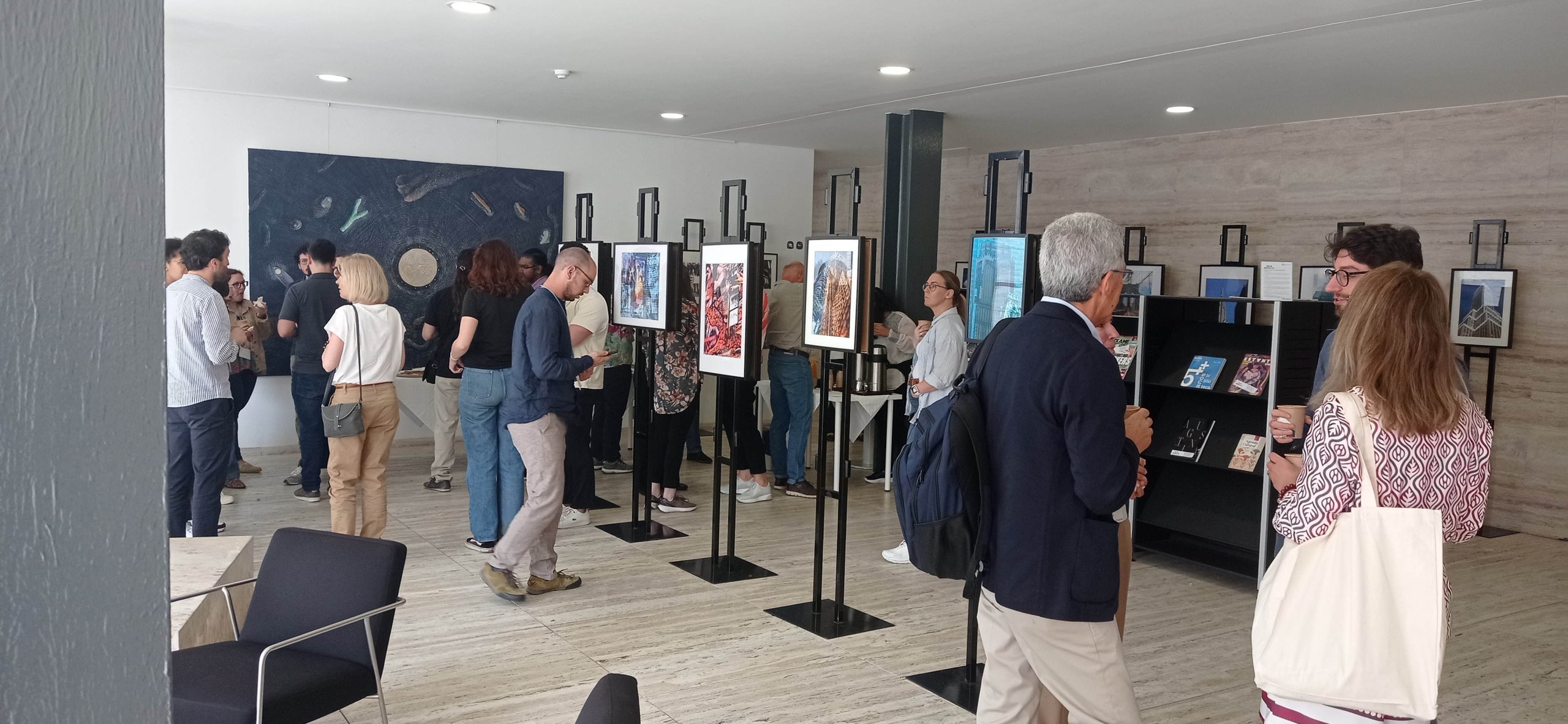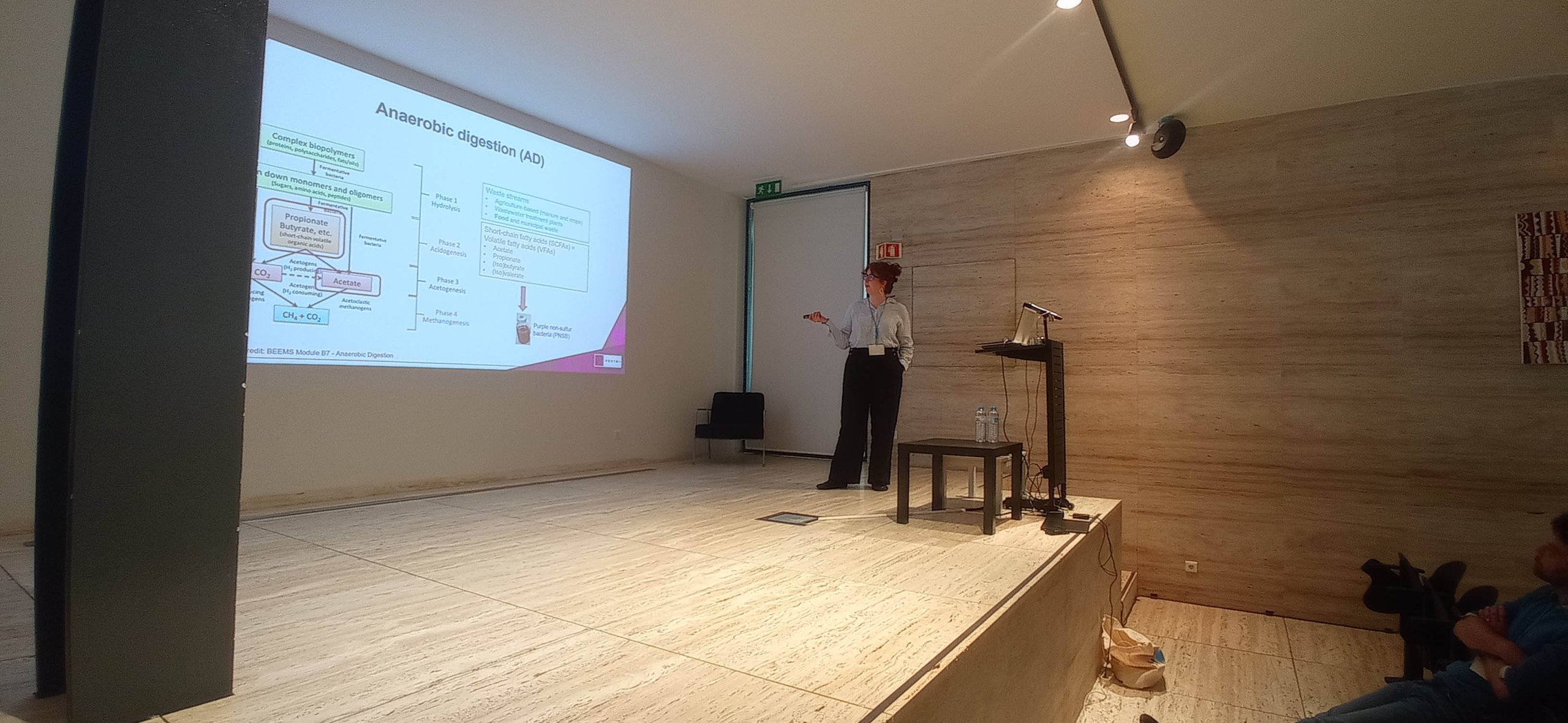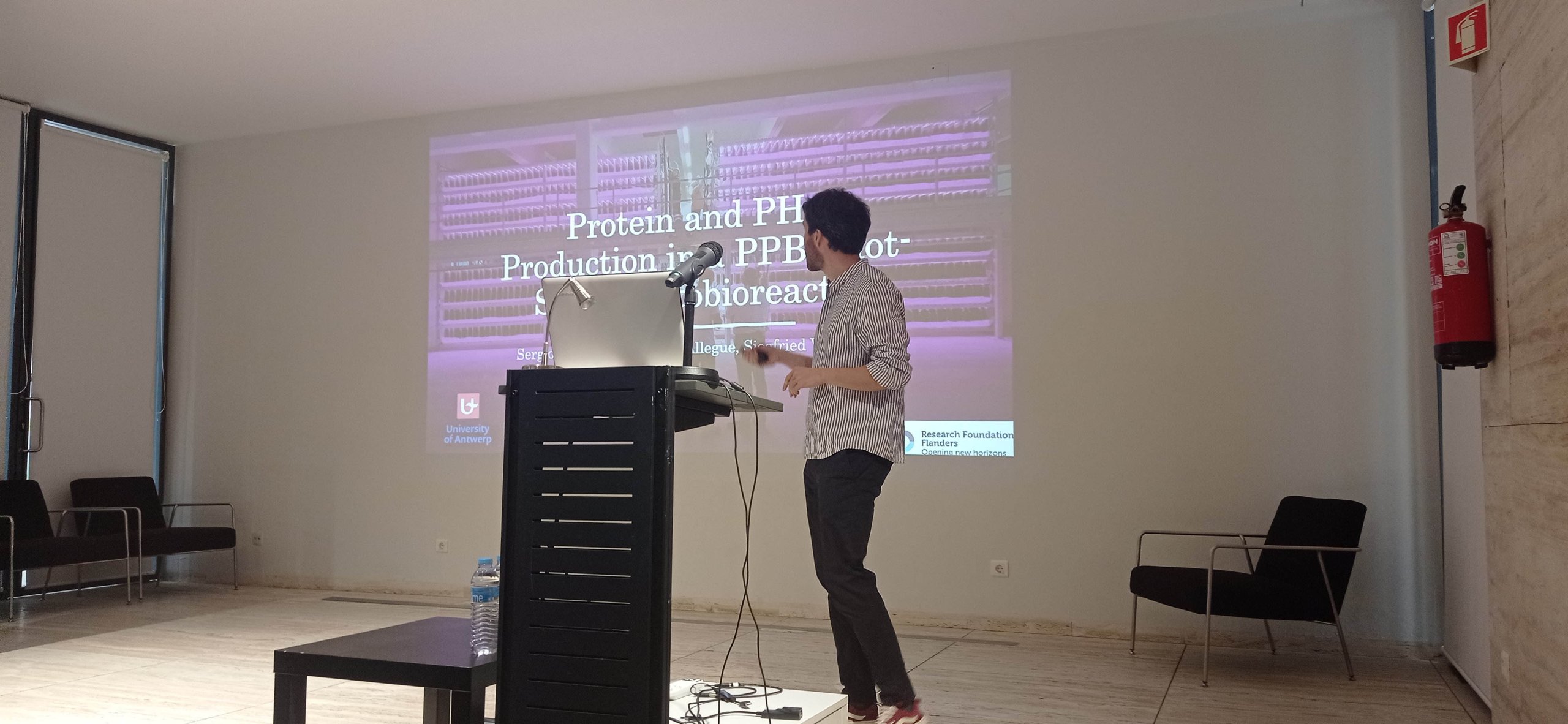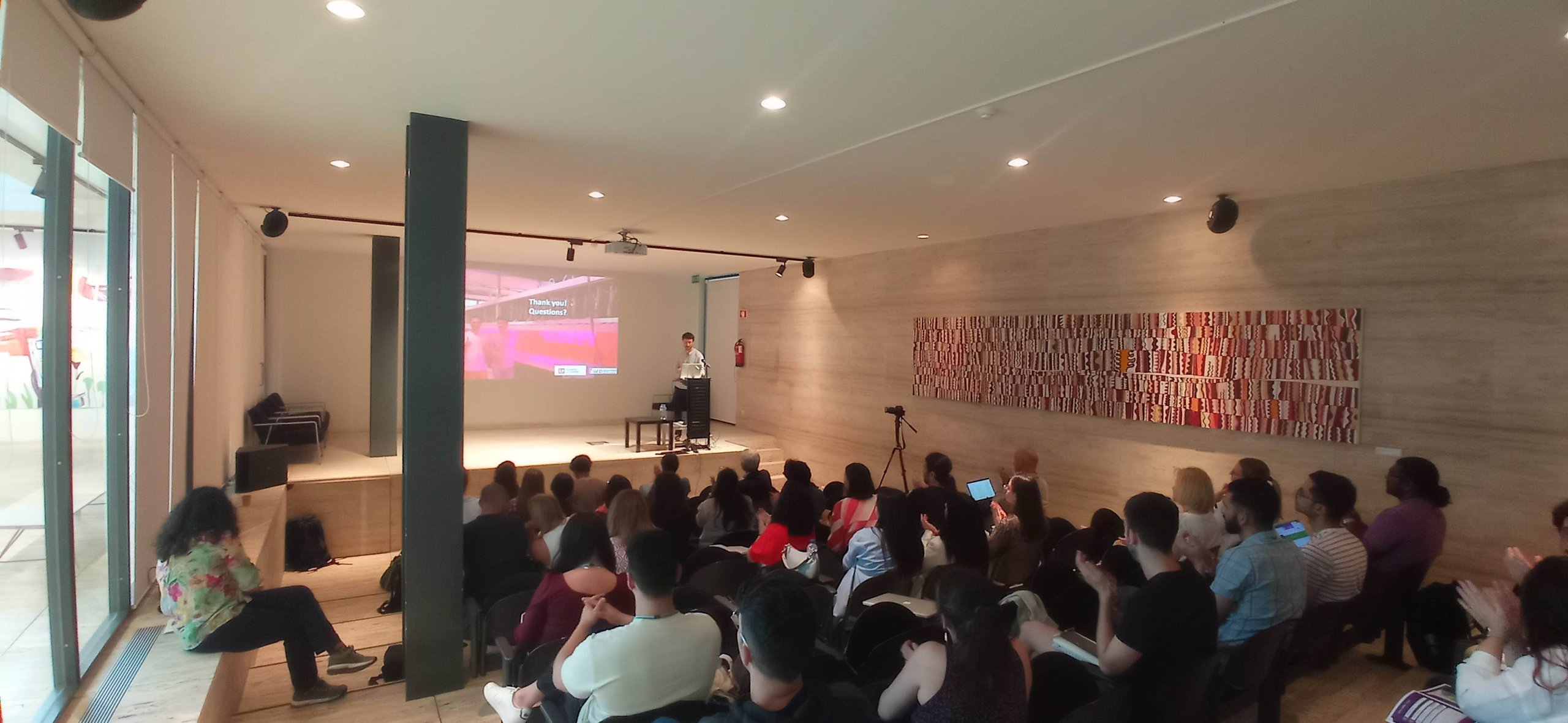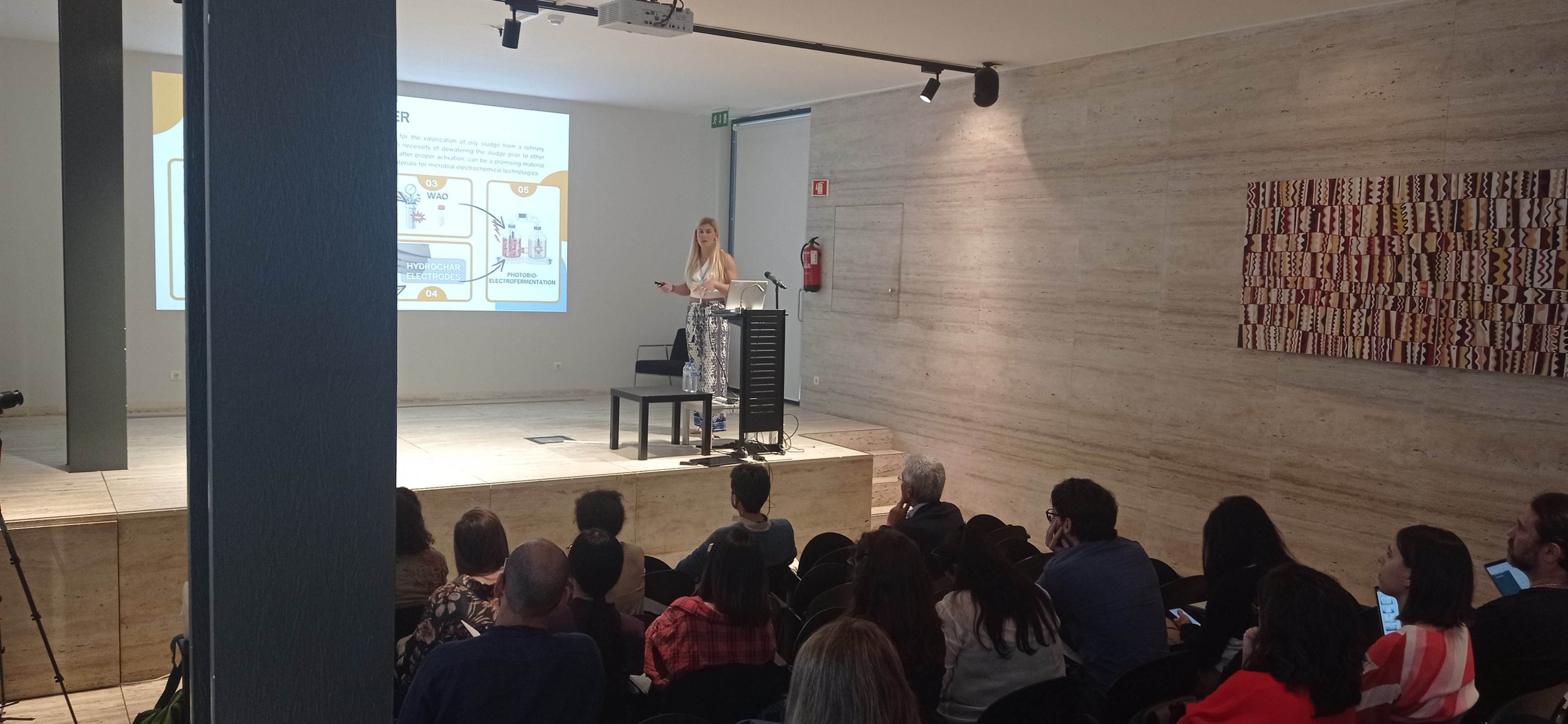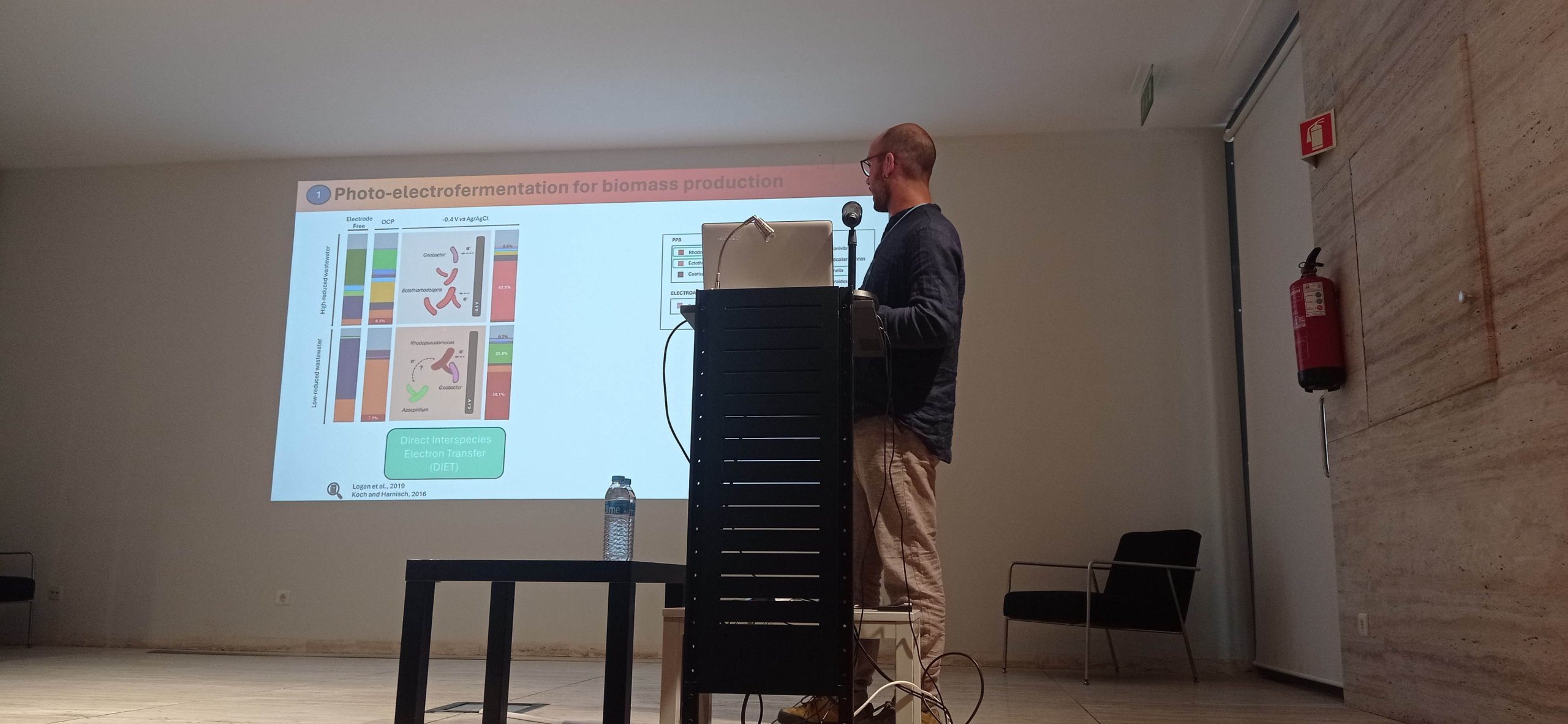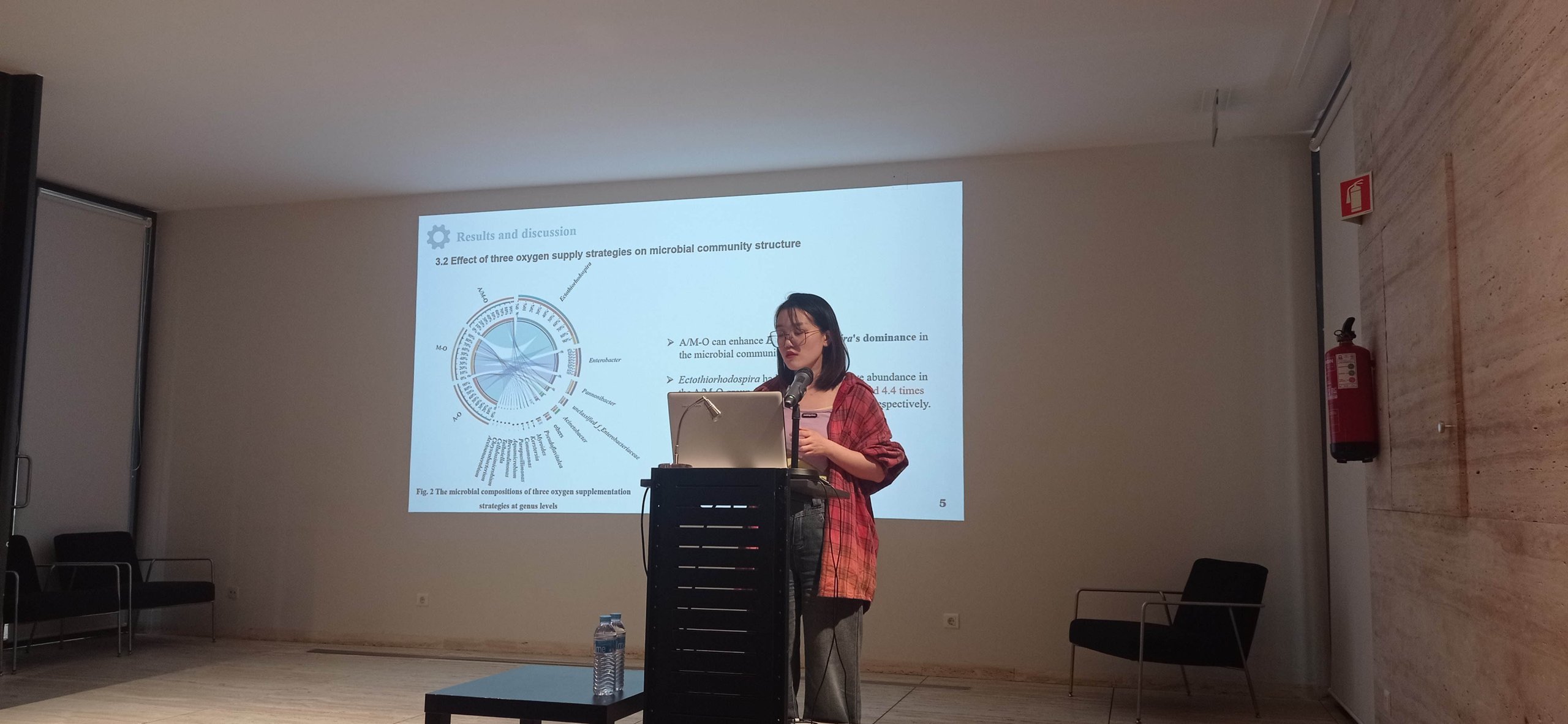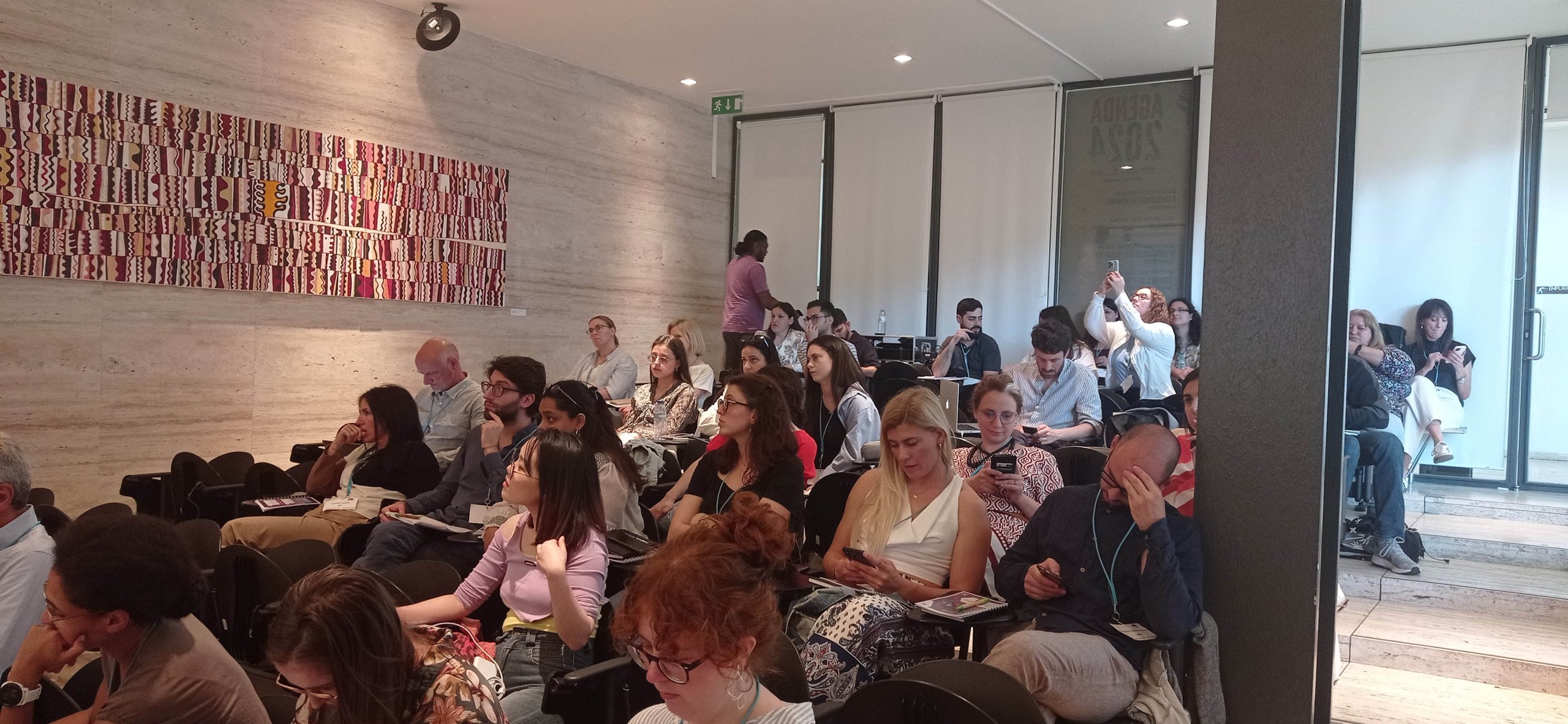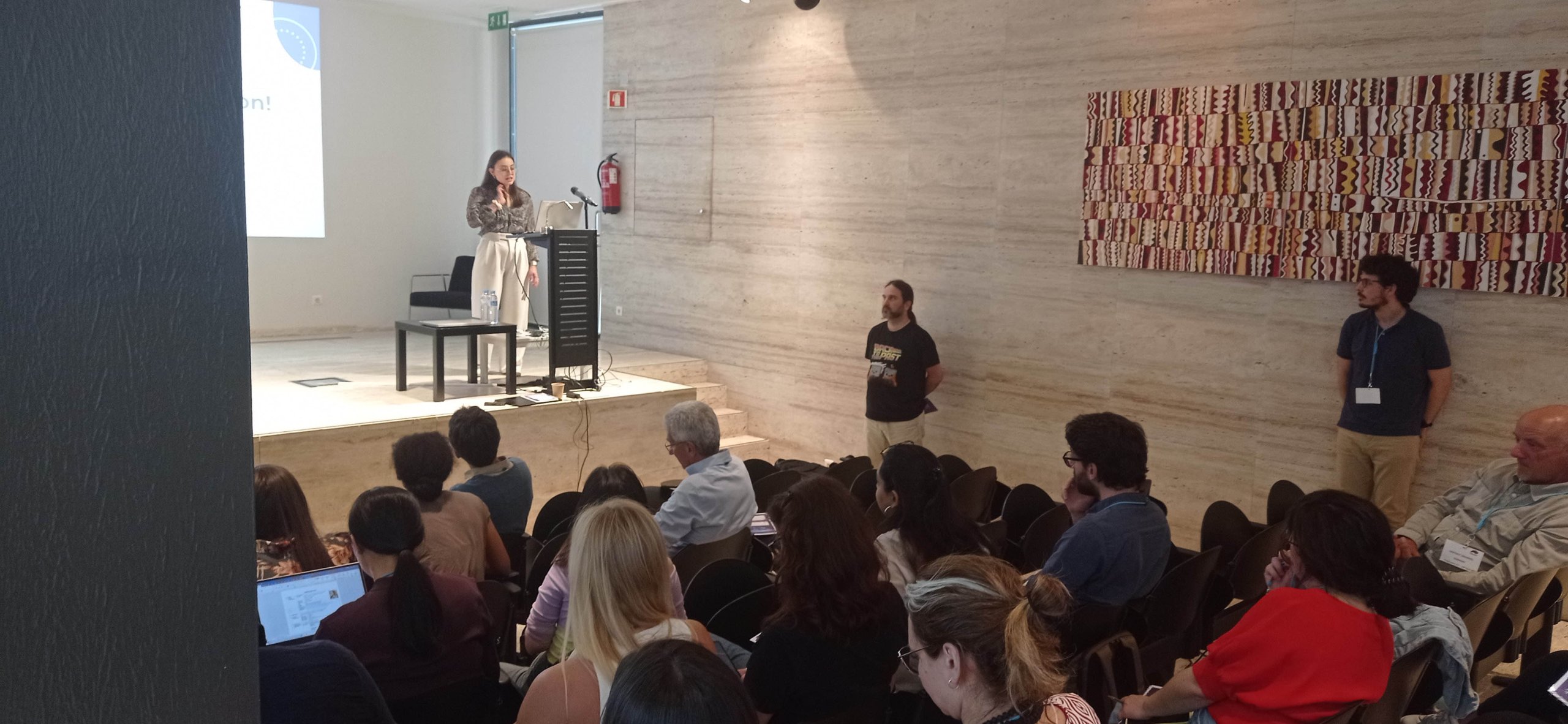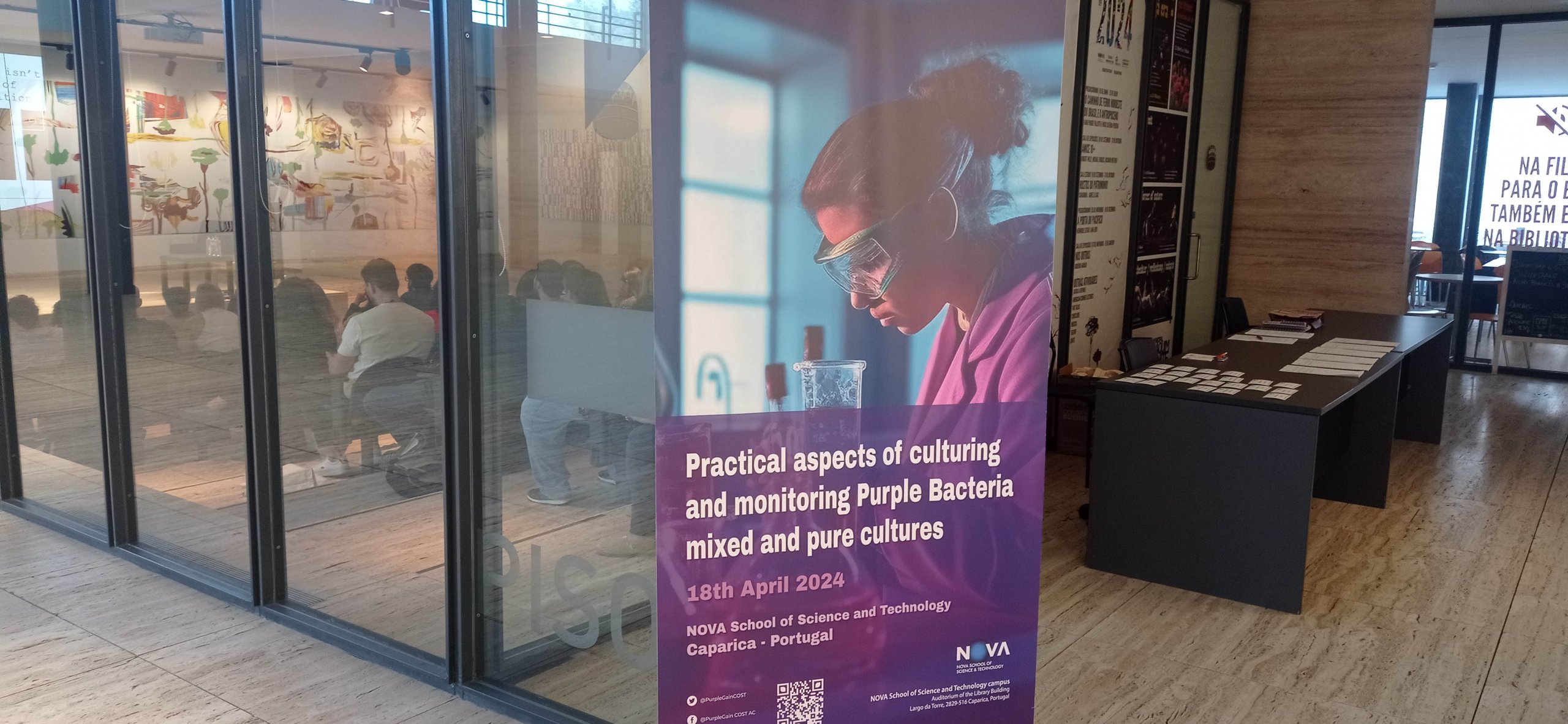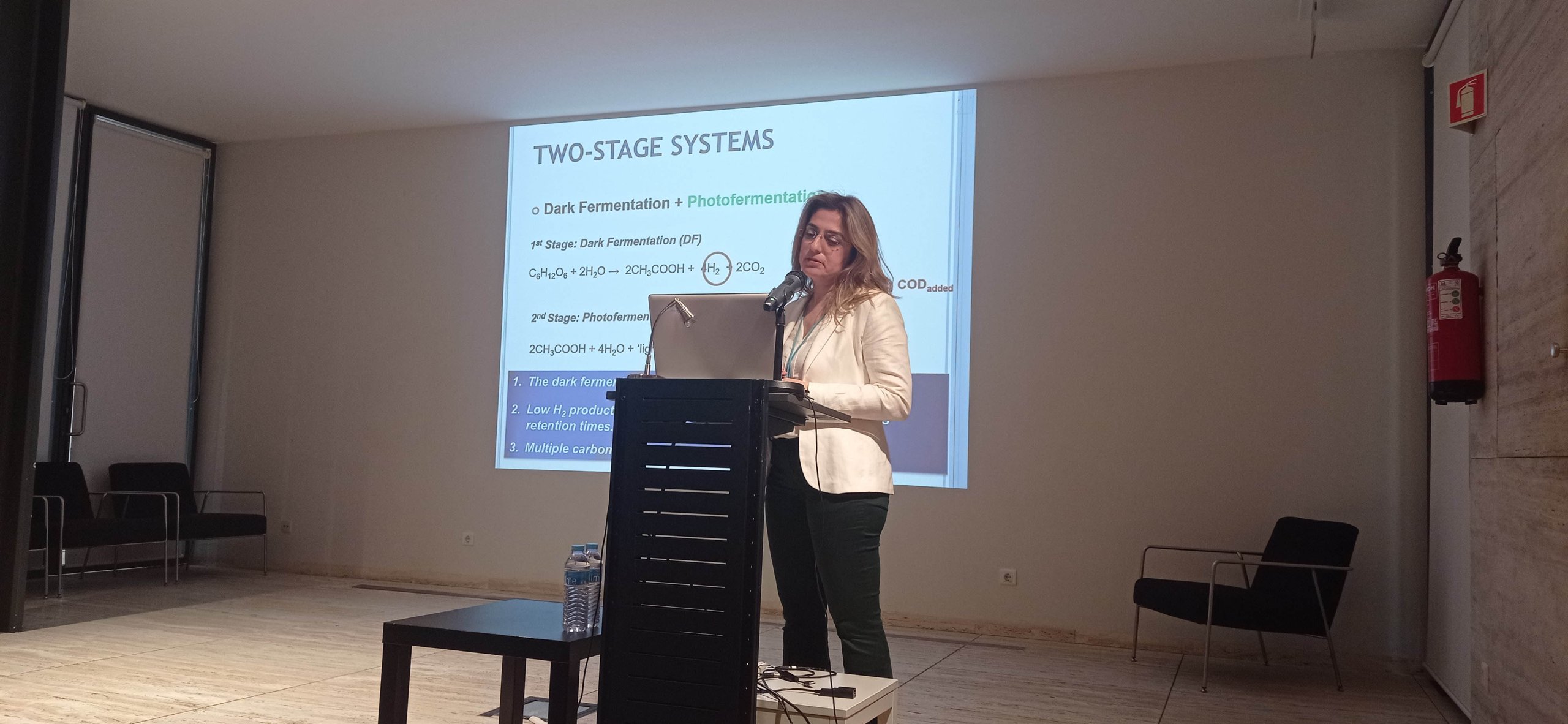4th Workshop
Practical aspects of culturing and monitoring Purple Bacteria mixed and pure cultures
18 April 2024
Lisbon – Portugal
KEY DATES
- Celebration date: 18th April of 2024, Lisboa, Portugal
- Extended date to registration: 31st March 2024
- Communication, confirmation and funding (if applicable in the form of reimbursement):8th March 2024
- Early bird registration: 31st March 2024
COST Action
COST Action CA21146
COST Action CA21146 is a four-year networking action that aims at creating a European network to share information, facilitating technology and knowledge transfer between the academic and industrial sectors, related to Purple Photosynthetic Bacteria (PPB) applications for resource recovery from organic waste sources. Resource recovery includes wastewater or organic waste, open or closed environments, in single or chain processes.
The network associates fundamental-focused and applied research groups, improving lab-scale technology optimization through mechanistic modeling. It benefits the technology transfer from applied-research groups to industry, considerably improving process design. PURPLEGAIN also aims to create a database for techno-economic, social and environmental impacts studies, which facilitates the marketability of both the PPB-based technologies and the products to extract. Some focused products are polyhydroxyalkanoates, single-cell proteins, biomass for energy, biomass as fertilizer, biohydrogen, carotenoids, terpenoids, organic acids, coenzyme Q10, and 5-aminolevulinic acid.
COST
COST is an intergovernmental framework for European Cooperation in Science and Technology established to initiate networking and coordination of nationally funded research activities on a European level. It facilitates bringing good scientists together under light strategic guidance based on networks, called COST Actions, centred around research projects in fields that are of interest to COST countries and cooperating countries.
4th Workshop
Presentation
The workshop is organized by Dr. Joana Fradinho (Vice Chair and head of the local organizing committee), Dr. Daniel Puyol (Chair), Dr. Gabriel Capson Tojo (Working Group 2 Leader), Dr. Luis Diaz Allegue, WG2 co-Leader, Dr. Raul Muñoz Torre – Grant Awarding Coordinator, Dr. Ioanna Vasiliadou (Training Schools Coordinator), in the frame of WG 2: Resource recovery from waste and wastewater and downstream procedures for PPB biomass of the COST action (CA21146) – PURPLEGAIN.
- Celebration date: 18th April 2024, Lisboa, Portugal
- Key dates:
- Final date to apply for funding: 8th March 2024.
- Communication, confirmation and funding (if applicable in the form of reimbursement): 8th March 2024.
- Early bird registration: 31st March 2024.
- Registration: Fourth Workshop – Registration
- Organizing committee: Dr. Joana Fradinho (Vice Chair and head of the local organizing committee), Dr. Daniel Puyol (Chair), Dr. Gabriel Capson Tojo (Working Group 2 Leader), Dr. Luis Diaz Allegue, WG2 co-Leader, Dr. Raul Muñoz Torre – Grant Awarding Coordinator, Dr. Ioanna Vasiliadou (Training Schools Coordinator).
Scope
PURPLEGAIN aims to create a European network to share information, facilitating technology and knowledge transfer between the academic and industrial sectors, related to PPB applications for resource recovery from organic waste sources. Resource recovery includes wastewater or organic waste, open or closed environments, in single or chain processes. The network associates fundamental-focused and applied-research groups, improving lab-scale technology optimization through mechanistic modeling. It benefits the technology transfer from applied-research groups to industry, considerably improving process design.
PURPLEGAIN also aims to create a database for techno-economic, social and environmental impacts studies, which facilitates the marketability of both the PPB-based technologies and the products to extract. Some focused products are polyhydroxyalkanoates, single-cell proteins, biomass for energy, biomass as fertilizer, biohydrogen, carotenoids, terpenoids, organic acids, coenzyme Q10, and 5-aminolevulinic acid.
Accordingly, the workshop in the frame of Working Group 2, which coordinates the initiatives focused on applied research, exploring operational strategies for combined product development, is focused on two main Topics:
- First Topic: Wastewater treatment with purple phototrophic bacteria and resource recovery from organic waste sources in purple photo-biorefineries
- Second Topic: Downstream processing: advances in extraction and purification of high added-value molecules, and engineering challenges: scale-up of photo-bioreactors, including control and light integration.
Call for participating
This is a call for participating in the 4th Workshop “Practical aspects of culturing and monitoring Purple Bacteria mixed and pure cultures” in the frame of WG 2: Resource recovery from waste and wastewater and downstream procedures for PPB biomass of the COST action (CA21146) – PURPLEGAIN.
We invite abstract contributions for oral presentations to this interdisciplinary workshop from all academic disciplines (PhD students, young researchers, post-doctoral and senior researchers, and professors) and other stakeholders.
Due to the Council Decision 2022/2056, as of 4 July 2023 and until further notice:
- Participation and eligibility of COST Action participants affiliated with Hungarian legal entities implied by the Council Decision shall be suspended for all COST Actions and COST activities. Therefore, these COST Action participants shall not be invited to participate in any type of Action activities. The Grant Holders must cancel the attendance of any Hungarian participants invited before 4 July to future Action activities. If these participants already incurred non-refundable expenses prior to 4 July, they are invited to contact the Administrative Officer of the respective Action.
- Management Committee and Working Group participants affiliated with Hungarian legal entities implied by the Council Decision are suspended from this role. In case Actions receive new MC or WG membership applications from the affected Hungarian legal entities, please note that the request(s) cannot be approved. The MC should decline any new WG membership requests from any members of the said Hungarian institutions;
- No Action activity is allowed to take place in any of these concerned Hungarian institutions;
- No Hungarian participants affiliated with the said mentioned institutions shall be invited or reimbursed for attending any Action activity after 4 July. Any such reimbursement will be removed from e-COST and the paid expenses will be borne by the Grant Holder Institutions.
In this regard, the Annex I of Level A Country and Organisations table has been updated to include these measures.
Please consult the list of above-mentioned institutions here: List of institutions affected by Council Implementing Decision 2022/2056.
Should you have any further questions, please contact the GH Manager of your Action
Rules for abstract submission
- Abstracts should have a maximum of 350 words (download the Abstract Template).
- Contributors could apply for financial support (see financial support section).
Venue
The PurpleWeek will take place at NOVA School of Science and Technology (FCT NOVA). As seen on the map, the venue is located on the south side of Tagus River, with Lisbon located on the north side of the river. The airport and some recommended hotels are also highlighted.
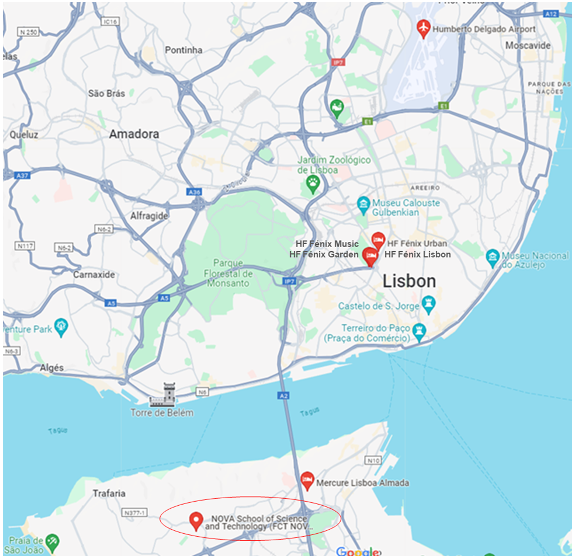
Within the NOVA School of Science and Technology campus, the Workshop event will take place at the Auditorium of the Library Building (18th April) (see map below).
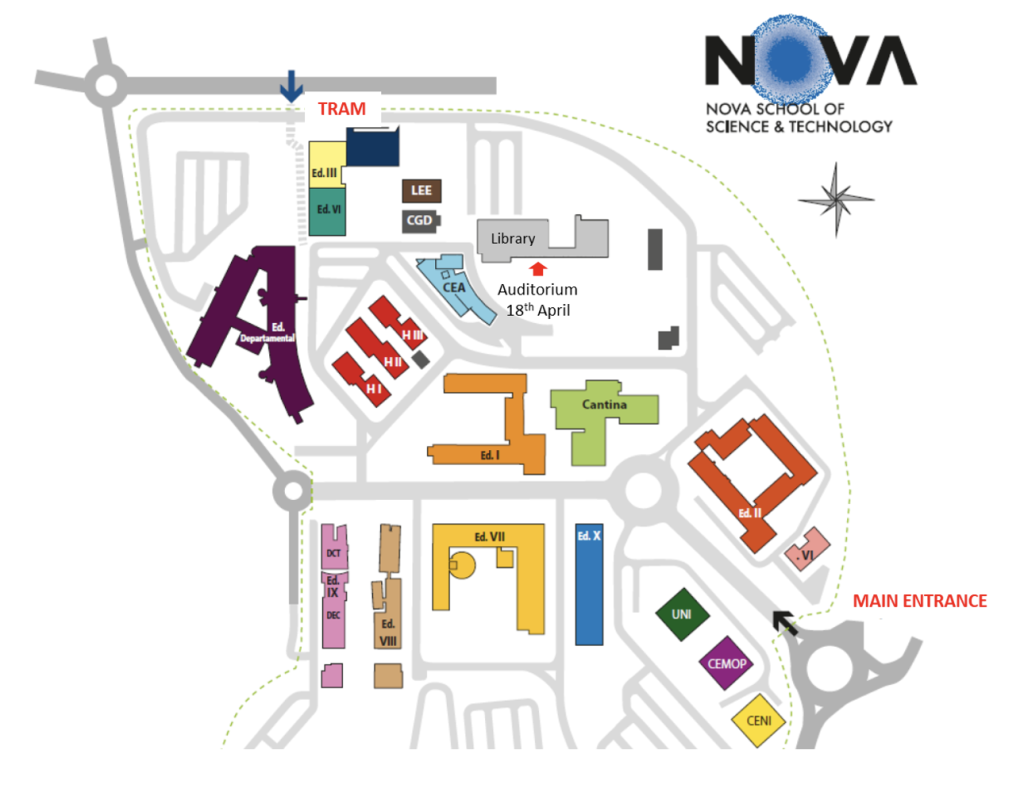
Program
8:30-9:00|Registration
9:00-13:00|SESSION I
09:00 – 10:00 | Dr. Baptiste Leroy (Professor, Department of Proteomics and Microbiology, Université de Mons)
The mighty power of photosynthesis
Planet Earth sustains all its life forms by exploiting photosynthesis, a paramount biological process performed by plants, algae, and some bacteria. Photosynthesis is the sole biological process able to fix energy on Earth by harvesting sunlight. The planetary relevance of such metabolic process was clear to Giacomo Ciamician, one of the founders of modern photochemistry who delivered a visionary in 1912 speech [1] on the urgency of substituting fossil fuels with “The enormous quantity of energy that the Earth receives from the sun”, anticipating by more than one century what is now an almost universally shared opinion.
Two wars, the availability and handiness of fossil fuels and many skeptical world’s leaders have pushed the much-needed deadline for leaving the carbon based energy production further and further. Eventually, spurred by the vision of Ciamician, at the end of the last century the idea of artificial photosynthesis for producing sustainable energy kicked in the scientific community.
Twenty some years and many attempts later, awareness struck: complexity is the key to harness the energy from the Sun and no matter how hard you try, you cannot outdo the primary energy transducers fine-tuned by billions of years of evolution. A lesson learned the hard way, similarly to the way Pinocchio [2] learnt his after meeting the Fox and the Cat, agreed to reach the Field of Wonders in the City of Simple Simons and bury coins.
More recently, the possibility to use whole, metabolically active photosynthetic organisms in technological applications is gaining momentum in the scientific community. Results appear interesting and promising. In other words, if you can’t beat photosynthetic organisms, join them!
The recent attempts made in our laboratory to harness light and exploit it [3-7] are a useful little roadmap to employ photosynthetic bacteria in environmental applications.
10:00 – 10:30 | Dr. Tuba Hande Erguder (Professor, Department of Environmental Engineering, Middle East Technical University)
The mighty power of photosynthesis
Planet Earth sustains all its life forms by exploiting photosynthesis, a paramount biological process performed by plants, algae, and some bacteria. Photosynthesis is the sole biological process able to fix energy on Earth by harvesting sunlight. The planetary relevance of such metabolic process was clear to Giacomo Ciamician, one of the founders of modern photochemistry who delivered a visionary in 1912 speech [1] on the urgency of substituting fossil fuels with “The enormous quantity of energy that the Earth receives from the sun”, anticipating by more than one century what is now an almost universally shared opinion.
Two wars, the availability and handiness of fossil fuels and many skeptical world’s leaders have pushed the much-needed deadline for leaving the carbon based energy production further and further. Eventually, spurred by the vision of Ciamician, at the end of the last century the idea of artificial photosynthesis for producing sustainable energy kicked in the scientific community.
Twenty some years and many attempts later, awareness struck: complexity is the key to harness the energy from the Sun and no matter how hard you try, you cannot outdo the primary energy transducers fine-tuned by billions of years of evolution. A lesson learned the hard way, similarly to the way Pinocchio [2] learnt his after meeting the Fox and the Cat, agreed to reach the Field of Wonders in the City of Simple Simons and bury coins.
More recently, the possibility to use whole, metabolically active photosynthetic organisms in technological applications is gaining momentum in the scientific community. Results appear interesting and promising. In other words, if you can’t beat photosynthetic organisms, join them!
The recent attempts made in our laboratory to harness light and exploit it [3-7] are a useful little roadmap to employ photosynthetic bacteria in environmental applications.
10:30 – 11:15 |Oral Presentation
10:30 – 10:45 |Manon Gilson, Guillaume Bayon-Vicente, Ruddy Wattiez, Baptiste Leroy
Assimilation of sucrose and its derivates by Rhodospirillum rubrum and Rhodobacter capsulatus
10:45 – 11:00 | Rossella Labarile, Maria Varsalona, Danilo Vona, Maria Teresa Melillo, Paolo Stufano, Chiara Mongiovì, Roberto Comparelli, Massimo Trotta
Dopamine effect on growth and morphology of the photosynthetic bacterium Rhodobacter sphaeroides
11:00 – 11:15 | Simone Krings, Ruddy Wattiez, Baptiste Leroy
Valorisation of organic waste for the production of high-value molecules
11:15-11:45|Coffee-Break
11:45 – 13:00 |Oral Presentation
11:45 – 12:00 |Sergio J. González Camara, Luis Díaz Allegue, Siegfried E. Vlaeminck
Optimizing Protein and PHA Production in Purple Non-Sulphur Bacteria in a Pilot-Scale photobioreactor
12:00 – 12:15 | Naïm Blansaer, Sergio González Cámara, Luis D. Allegue, Siegfried E. Vlaeminck and Arno G.B. Wouters
Extraction and characterization of microbial protein from phototrophic purple bacteria as a sustainable food ingredient
12:15 – 12:30 |Victor Galve, Amanda Prado, Fernando Martínez, Raúl Molin, Daniel Puyol
Photo-bio-electro-Fenton: a novel strategy for the complete abatement of industrial wastewater at low cost
12:30 – 12:45 | Fernando Muniesa-Merino, Carlos Manchon, Abraham Esteve-Nuñez
Photo-electroheterotrophic production of microbial biomass from brewery wastewater in purple phototrophic bacteria is enhanced in fluid-like cathodes
12:45 – 13:00 | Xiaodan Wang, Shichao He, Haifeng Lu, Jean-Philippe Steyer, Gabriel Capson-Tojo, Guangming Zhang
Effect of oxygen supplementation strategies on microbial community succession and carbon and nitrogen metabolism in photosynthetic bacteria wastewater resource system
13:00-14:30|Lunch Break
14:30-16:00|SESSION II
14:30 – 15:30 | Dr. Roberto De Philippis (Professor, Department of Agriculture, Food, Environment and Forestry (DAGRI) – University of Florence)
Purple phototrophs, electricity, and the circular economy
The Bose lab studies microbial metabolisms and their influence on biogeochemical cycling using a transdisciplinary approach. We apply the knowledge we gain to generate new ways of addressing issues such climate change, sustainability, and the circular economy. My lab’s recent work has focused on the ability of microbes to use solid-phase conductive materials as electron donors. The ability to use electrons from minerals and other solid-phase conductive materials (in essence using electricity) is called “Extracellular Electron Uptake” or (EEU). EEU fundamentally changes our perception of the ecological role of microbes (including phototrophs) in nature because it suggests that abundant elements (such as iron) can serve as electron sources for microbial productivity and survival. In addition, our work suggests that EEU might be a fundamental process that underlies microbial energy conservation ranging from terrestrial and aquatic ecosystems to the human body. The Bose lab has pioneered technologies to study EEU, driven fundamental knowledge in the field, and laid a solid foundation of tools and approaches to answer key questions about EEU in nature. We have applied this knowledge to produce carbon-negative bioplastics and carbon-neutral biofuels. Currently, we are pursuing fundamental and applied research on phototrophic EEU, and determining its role in microbial ecology in marine and freshwater ecosystems. We are leveraging this knowledge to develop a variety of climate technologies for the circular economy.
15:30 – 16:00 | Dr. Haifeng Lu (China Agricultural University and The Key Laboratory of Agricultural Engineering in Structure and Environment, Ministry of Agriculture and Rural Affairs of People’s Republic of China)
Purple phototrophs, electricity, and the circular economy
The Bose lab studies microbial metabolisms and their influence on biogeochemical cycling using a transdisciplinary approach. We apply the knowledge we gain to generate new ways of addressing issues such climate change, sustainability, and the circular economy. My lab’s recent work has focused on the ability of microbes to use solid-phase conductive materials as electron donors. The ability to use electrons from minerals and other solid-phase conductive materials (in essence using electricity) is called “Extracellular Electron Uptake” or (EEU). EEU fundamentally changes our perception of the ecological role of microbes (including phototrophs) in nature because it suggests that abundant elements (such as iron) can serve as electron sources for microbial productivity and survival. In addition, our work suggests that EEU might be a fundamental process that underlies microbial energy conservation ranging from terrestrial and aquatic ecosystems to the human body. The Bose lab has pioneered technologies to study EEU, driven fundamental knowledge in the field, and laid a solid foundation of tools and approaches to answer key questions about EEU in nature. We have applied this knowledge to produce carbon-negative bioplastics and carbon-neutral biofuels. Currently, we are pursuing fundamental and applied research on phototrophic EEU, and determining its role in microbial ecology in marine and freshwater ecosystems. We are leveraging this knowledge to develop a variety of climate technologies for the circular economy.
16:00 – 16:30 |Oral Presentation
16:00 – 16:15 | Dimitra Matziri, Nikolaos Remmas, Konstantinos Christoforidis, Ioanna Vasiliadou, Paraschos Melidis, Spyridon Ntougias
Enhancing Hydrogen Production from Cheese Whey: A Comparative Study of Dark and Photo Fermentation Bioprocesses
16:15 – 16:30 | Tugba Keskin-Gungodu, Patrick C. Hallenbeck
Assessing Environmental Sustainability: Life Cycle Analysis of Biohydrogen Production from Sugar Industry Wastes via Photofermentation
16:30-17:30|Coffee-Break
17:00-18:30|Round table discussion on “A guide for established protocols for PPB based products including economic prospects”
Purple phototrophs, electricity, and the circular economy
The Bose lab studies microbial metabolisms and their influence on biogeochemical cycling using a transdisciplinary approach. We apply the knowledge we gain to generate new ways of addressing issues such climate change, sustainability, and the circular economy. My lab’s recent work has focused on the ability of microbes to use solid-phase conductive materials as electron donors. The ability to use electrons from minerals and other solid-phase conductive materials (in essence using electricity) is called “Extracellular Electron Uptake” or (EEU). EEU fundamentally changes our perception of the ecological role of microbes (including phototrophs) in nature because it suggests that abundant elements (such as iron) can serve as electron sources for microbial productivity and survival. In addition, our work suggests that EEU might be a fundamental process that underlies microbial energy conservation ranging from terrestrial and aquatic ecosystems to the human body. The Bose lab has pioneered technologies to study EEU, driven fundamental knowledge in the field, and laid a solid foundation of tools and approaches to answer key questions about EEU in nature. We have applied this knowledge to produce carbon-negative bioplastics and carbon-neutral biofuels. Currently, we are pursuing fundamental and applied research on phototrophic EEU, and determining its role in microbial ecology in marine and freshwater ecosystems. We are leveraging this knowledge to develop a variety of climate technologies for the circular economy.
Accommodation and Transportation information
Room rates
1. Room rates of Mercure Lisboa Almada Hotel (Located on the South side of Tagus River)
| Appellation | Room rates in EUR/room/night |
| Single room | EUR 80 (VAT included) |
| Single room with breakfast | EUR 90 (VAT included) |
| Double room with breakfast | EUR 100 (VAT included) |
2. Room rates for HF Hotels: HF Fénix Lisboa / HF Fénix Urban / HF Fénix Garden / HF Fénix Music (Located in Lisbon city center)
PurpleWeek has an agreement with HF Hotels with a dedicated website link where you can choose among 4 HF hotels and make your reservation with discount prices for the event (prices are per room). Note that the prices are not fixed and may change until the celebration date of the event.
Link: https://purpleweek24.hfhotels.com/corporate/
About the price
In order to make reservations please send an email to ha040-re@accor.com. In the email please indicate the code PWEEK-FCT to have access to the mentioned prices.
Payment method
Reservations can be paid in advance through bank transfer (up to 3 days before arrival) or locally at the hotel. Once you make the reservation via email, the Hotel will provide you the details to make the bank transfer.
Parking
There is on-site free covered car parking
Penalty-free cancellation deadline
- Penalty-free cancellation deadline: participants can cancel their reservation up until a week before upon arrival without penalty.
- Penalty: After the deadline, the price will be charged in full.
Transportation information
Transports at Humberto Delgado Airport, Lisbon
Humberto Delgado Airport, Lisbon is the nearest airport and there is a variety of transportation options to ensure smooth connectivity to and from the airport.
- Taxi Services and Ride-Sharing Apps: located outside the terminals.
- Public Transportation: Lisbon Airport is well-integrated into the city’s public transportation network.
- Metro: The red line (linha vermelha) of the Lisbon Metro serves the airport and provides a quick and cost-effective way to reach different parts of Lisbon. Passengers can access the metro station from Terminal 1.
- Buses: Various bus routes operate from the airport, serving different areas within Lisbon and its surroundings. Passengers can find bus stops conveniently located outside both Terminal 1 and Terminal 2.
Transports at the venue, Nova School of Science and Technology (FCT NOVA)
When considering your options be aware that Nova School of Science and Technology (FCT NOVA) is not located in the city center of Lisbon but on the south side of the Tagus River. Nevertheless, the campus is easily accessible through several public transportation.
- Taxi or Ride-Sharing: Taxi and ride-sharing services are readily available in the area. You can use apps like Uber or Bolt to conveniently reach the campus. It takes about 15 to 25 minutes to arrive at FCT NOVA from Lisbon (prices around 15€).* This is the recommended transportation choice for those staying in Lisbon
- Public Transportation: FCT NOVA is well-connected by public transportation. You can reach the campus by:
- Bus: Several bus lines connect the campus with different parts of Lisbon and neighbouring areas. Check the official website of the Carris Metropolitana for detailed bus routes and schedules.
- Bus (to Monte da Caparica (FCT)): https://www.carrismetropolitana.pt/planeador/
- Train: The nearest train station is Pragal. From there, you can take a bus, taxi or metro to reach FCT NOVA. Trains run frequently from Lisbon’s main stations such as Roma-Areeiro, Entrecampos, Sete Rios and Campolide.
- Train (to Pragal): https://www.fertagus.pt/pt/viajar/mapa-de-rede
- Metro (to Universidade): https://www.mts.pt/horarios/
- Bus: Several bus lines connect the campus with different parts of Lisbon and neighbouring areas. Check the official website of the Carris Metropolitana for detailed bus routes and schedules.
Transportation Guide from Mercure Lisboa Almada Hotel and HF Fénix (Lisbon) to FCT NOVA venue
1. From Mercure Lisboa Almada Hotel:
- By Public Transportation: Metro (to Universidade): https://www.mts.pt/horarios/

- Take a short walk (about 4 min.) to the Ramalha metro station, board on the metro heading to Universidade, and exit at the Universidade stop (~15 min).
- Direct buses, taxis or ride-sharing (Uber, Bolt) are also available.Bus (to Monte da Caparica (FCT)): https://www.carrismetropolitana.pt/planeador/
2. From HF Fénix:
For those staying at the HF Fénix hotels (located in Marquês de Pombal, Lisbon), the easiest and direct route to reach FCT NOVA is by using a taxi or a ride-sharing service app such as Uber or Bolt (15 to 25 min).
By public transportation:
Bus (to Monte da Caparica (FCT)): https://www.carrismetropolitana.pt/planeador/
Take a short walk to the bus stop Marquês de Pombal (P6), board on 3709 bus heading towards Costa da Caparica (Terminal) and exit at Monte da Caparica (FCT) stop, which is right in front of FCT NOVA campus.
Besides the 3709 bus, previously mentioned, other buses are heading to Monte da Caparica (FCT) stop, departing nearby the HF Félix hotels easily accessed by metro (blue line from Marques de Pombal or Parque station):
- In Sete Rios and Praça de Espanha, bus 3711 (heading to Monte da Caparica (FCT)
- In Sete Rios and Praça de Espanha, bus 3705 (heading to Charneca da Caparica (centro)
- In Praça de Espanha, bus 3710 (heading to Costa da Caparica (terminal)
Financial Support – Application procedure for reimbursement
Documentation for applying
The documentation needed for applying for reimbursement are as follows:
- Applicants must upload a short Curriculum Vitae (in English).
- Applicants must upload a motivation letter (in English).
- Applicants must upload a scanned copy of their passport (if applicants do not have a passport, they can upload their national ID card)
Selection criteria
The selection criteria for participants that will be eligible for reimbursement will comply with the COST Excellence and Inclusiveness Policy, in the implementation of the Action and will encourage attendance by a diverse selection of participants in consideration of:
- Underrepresented groups, including those with disabilities. Priority will be given to underrepresented groups, including those with disabilities.
- Gender balance.
- The level of involvement of Inclusiveness Target Countries (ITCs). Priority will be given to participants form Inclusiveness Target Countries. The current list of ITCs include Albania, Armenia, Bosnia and Herzegovina, Bulgaria, Cyprus, Czech Republic, Estonia, Croatia, Georgia, Greece, Hungary, Lithuania, Latvia, Malta, Moldova, Montenegro, Poland, Portugal, Romania, Slovenia, Slovakia, Republic of North Macedonia, Republic of Serbia, Turkey and Ukraine.
- The level of involvement of Early Career Investigators (ECIs). Priority will be given to PhD students and young post-doctoral researchers, followed by senior post-doctoral researchers and professors.
- In addition, Training School organizers may also consider other special attributes such as
- Type, or level of expertise in the field of the Workshop based on the curriculum vitae,
- Appropriate core knowledge and understanding
- Willingness to participate based on the motivation letter
- Demonstrated interest based on the motivation letter
- The positive impact that the participants will have on the applicant’s future carrier
- Willingness to make a presentation in the Workshop session.
Financial support
Financial support through reimbursement does not necessarily cover all expenses but is a contribution to the overall travel, accommodation and meal expenses.
The financial contribution for each successful applicant shall respect the following criteria:
- Up to a maximum of EUR 650 in total can be afforded to each successful applicant from ITC country.
- Up to a maximum of EUR 450 in total can be afforded to each successful applicant from non-ITC country.
- Up to a maximum of EUR 150 in total can be afforded to each successful applicant from Portugal (distances > 100km from the Workshop Venue).
Please remind that this financial contribution must be understood as a financial aid aimed to help applicants to cover the expenses of their participation in the Workshop. This financial aid does not aim to cover 100% of the expenses.
Please see the General Rules to be reimbursed (https://purplegain.eu).
Evaluation process and result announcement
Evaluation process
The selection committee, composed of the Action Chair, the Vice Chair, the Grant Awarding coordinator, the Training Schools Coordinator and the WG2 Leader and co-Leader, will evaluate the applications within an 18-days period (after the abstract submission deadline) and will inform all the applicants for their evaluation results. The successful applicants will then receive an e-mail from the grant holder (Grant Letter Notification), stating the official approval of the reimbursement, the granted budget and a payment request form which has to be completed after the completion of the Workshop.
Criteria of reimbursement
If the amount of reimbursement by all applications within a call does not exceed the available budget, the applications are handled by the selection committee. If there are more applications than funding is available, the following procedure takes place.
- A list of all applications (containing an informative summary) is distributed to all members of the selection committee in form of a table in which every evaluator can mark which applications he or she can evaluate according to their field of expertise.
- To guarantee a fair and objective evaluation, an evaluator should have no affiliation with neither the home nor the host institution of the application in question.
- All applications are evaluated by two members of the selection committee. The Grant Awarding coordinator distributes the proposals to the individual evaluators.
- The criteria given in the table below shall be applied for evaluation. The first criterion (a) is assessed by the Grant Awarding coordinator prior to the evaluation process.
| Criterion | Max. points |
| a) Before any further criteria are considered | |
| Application is complete and fulfils all formal requirements | pass/no pass |
| The application will be ranked last if the applicant was granted in previous call | pass/no pass |
| b) Evaluation of the proposal | |
| Applicant from ITC country | 0 or 10 |
| Applicant is ECI (or promotes gender balance) | 0 or 10 |
| Impact on the career of the applicant | 15 |
| Willingness to participate based on the motivation letter | 10 |
| Willingness to make a presentation in the Workshop session | 10 |
| CV of the applicant | 10 |
| Relevance to the objectives of PurpleGain Action | 20 |
- The evaluators report their evaluations to the Grant Awarding coordinator.
- The Grant Awarding coordinator ranks all evaluations and then reports the final result to the selection committee to be discussed and accepted.
- The applicants are informed about the decision reached.
More information
For further information, you may contact the
- Dr. Joana Fradinho – Local Organizer, Vice-Chair
- Dr Daniel Melchor Puyol Santos – Chair
- Dr Raul Muñoz Torre – Grant Awarding Coordinator
- Dr. Gabriel Capson-Tojo – WG2 Leader
- Dr. Luis Diaz Allegue – WG2 co-Leader
- Dr. Ioanna Vasiliadou – Training Schools Coordinator


